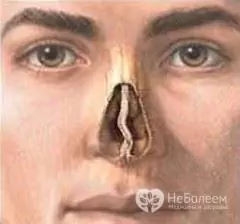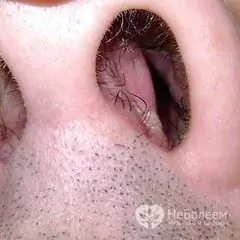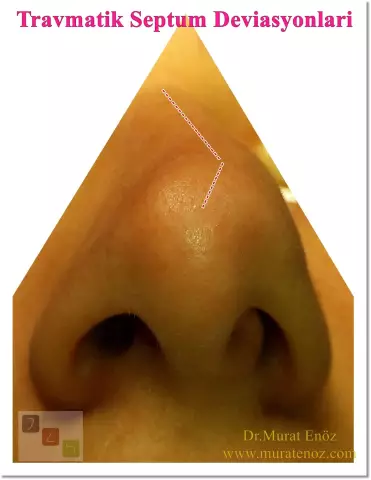- Author Rachel Wainwright [email protected].
- Public 2023-12-15 07:39.
- Last modified 2025-11-02 20:14.
Curvature of the nasal septum

Curvature of the nasal septum is a fairly common occurrence that can often be seen in adults and children. Often, a crooked septum is the cause of shortness of breath, sinusitis, runny nose and other complications.
Treatment of curvature of the nasal septum can only be surgical. Surgery on a deviated nasal septum is called septoplasty.
Causes of the curvature of the nasal septum
The most common cause of curvature of the nasal septum is a mismatch in the growth rates of the bone and cartilaginous parts of the nasal septum, i.e. anatomical defect. Other common causes include injuries to the nose, as well as the presence of nasal conditions such as polyps, thickening of the turbinates, etc.
The nasal septum is an anatomical formation located in the nasal cavity and dividing it into two equal parts. In turn, the nasal septum also consists of two parts: the anterior cartilaginous, and the posterior bone, located deep in the nasal cavity. The cartilaginous part of the septum can be easily felt if you run your finger along the nasal bridge. It is pliable and elastic to the touch, therefore it is more susceptible to damage from injury.
Types of curvature of the nasal septum
There are three main types of curvature of the nasal septum, depending on the cause:
- Physiological, which is due to a mismatch in the growth rates of the cartilaginous and bone parts of the septum. A similar curvature begins in childhood.
- Compensatory, which develops during constant irritation of the cartilaginous part of the nasal septum with a polyp, a too thickened nasal septum, or a foreign object;
- Traumatic curvature resulting from trauma. It is the traumatic curvature of the nasal septum that is the most common cause of difficulty breathing and nosebleeds.
Symptoms of the curvature of the nasal septum
To one degree or another, the curvature of the nasal septum exists in every person. However, it mostly does not cause discomfort, therefore, treatment of the curvature of the nasal septum is not required in this case. However, a significantly deviated nasal septum requires surgery. Surgery is needed when the following symptoms appear:
- snoring while sleeping;
- a visible change in the shape of the nose caused by a crooked nasal septum;
- difficulty in nasal breathing, sometimes so pronounced that the patient is forced to breathe through the mouth;
- frequent nosebleeds;
- frequent respiratory infections, runny nose, sinusitis, rhinitis, chronic pharyngitis, etc.;
- allergic vasomotor rhinitis, which manifests itself in a persistent runny nose, sneezing, nasal congestion, itching, clear nasal discharge.
The most common symptoms of curvature of the nasal septum in children are snoring during sleep, a constantly open mouth, nosebleeds, and rhinitis.
Treatment of curvature of the septum of the nose

According to reviews, surgery on a deviated nasal septum (septoplasty) is the most effective treatment.
Currently, traditional and laser septoplasty is used. You should be aware that laser septoplasty has a number of contraindications and is used only in case of slight curvature.
Traditional septoplasty is performed under local anesthesia. The surgeon performs all manipulations directly in the nasal cavity, so no scars and marks remain after the operation. The duration of surgery on a deviated nasal septum, according to reviews, may be different. In most cases, it ranges from half an hour to two hours and depends on the degree of curvature.
The effectiveness of the treatment can be judged only after the end of the recovery period, which is about two weeks.
The operation for children is carried out upon reaching the age of 14. However, if the symptoms of curvature are too pronounced, the child has difficulties with nasal breathing, rhinitis and other complications constantly occur, surgery is allowed from the age of six.
Possible complications after septoplasty
Complications after surgery can be roughly divided into early and late. Bleeding and bruising are early complications. To eliminate them, it is necessary to insert tampons into the nasal passages. A rather rare complication is perforation resulting from trauma to the nasal septum during surgery with a sharp object. In order to avoid this complication, the surgeon must carry out all the manipulations with extreme caution and thoroughness.
An abscess may occur due to the presence of purulent sinusitis and a blood clot in the run-up to the nose. To avoid an abscess, the surgical site must be thoroughly disinfected. The patient is recommended to take a course of antibiotics before the operation and for some time after it.
A late complication is a change in the shape of the nose associated with high resection of the quadrangular cartilage. It should be noted that such a complication is extremely rare.
Prevention of nasal septum curvature
To prevent curvature of the nasal septum, any injury or damage to the nose should be avoided. You should not take any vasoconstrictor drugs without a doctor's recommendation, since with prolonged use they provoke swelling of the mucous membrane, which aggravates nasal breathing with a curved nasal septum.
YouTube video related to the article:
The information is generalized and provided for informational purposes only. At the first sign of illness, see your doctor. Self-medication is hazardous to health!






